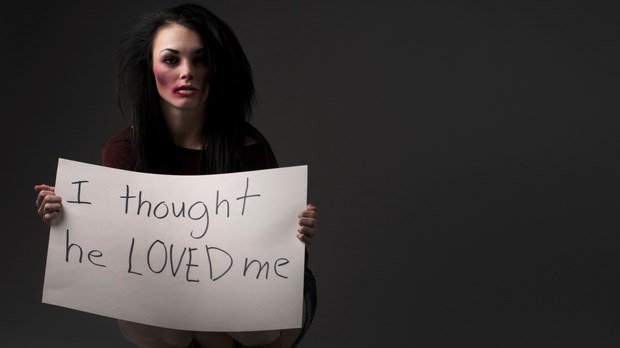The Hidden Problem of Domestic Violence

“He’s going to find me here. It’s only a matter of time,” she said with a resolved and fatal certainty.
She had driven hundreds of miles and multiple states away to stay at the women’s shelter where I worked as a counselor. With her kids in tow and nothing but what she could fit in her car, she came in the hopes of starting a new life. A safe life, free from her abuser.
She was hesitant to find work, fearing he would track her down through her tax information. And though I knew the lengths batterers went to in controlling their spouse, part of me questioned and doubted her fear, thinking there was no way he could find her from so far away.
Until he did just that.
A Worldwide Problem
Domestic violence. They are words you don’t hear in everyday talk at the office or at your weekly “Mommy and Me” class. That’s because domestic violence prefers to keep hidden behind closed doors and drawn curtains. It feels most comfortable lurking in the shadows, in whispers, downcast eyes, and long-sleeve shirts.
In fact, domestic violence is not something we hear about unless it happens to a friend or loved one. Occasionally though, abuse is forced out into public, and we see its ugly face splattered across the headlines. We see the bruises. We hear details that make us shutter in horror. And sometimes, like in the high-profile case of the NFL player Ray Rice, we see domestic violence in all its dark and hideous terror.
We wonder how something like that could happen. We ask why women stay with someone who hurts them, asking ourselves, Why don’t they just leave?
Such high-profile stories also make people consider their own relationships or those of people whom they know and love. Perhaps you have wondered about the intense yelling you hear between your friend and their spouse. Or maybe you are evaluating your own relationship and question if it is heading down a dangerous path. Maybe you’ve wondered what the difference is between an unhealthy marital or relationship conflict and that of abuse.
Those are all critical questions. Worldwide, a third of all women will be in an abusive relationship at some point in their lives. Domestic violence is no respecter of persons; it affects women of all ages, socioeconomic statuses, educations, ethnicities, and religions. Though it lives in the privacy of the home, its effect on society is high. According to the CDC, in 1995 the cost for abuse against women exceeded $5.8 billion. This includes the cost of medical and mental health care as well as the loss of work productivity.
Men can also be victims of domestic abuse—but in the majority of cases, the victims are women. For this reason, throughout this article, I’ve chosen to use male pronouns to describe the abuser and female pronouns to describe the victim.
Characteristics of an Abusive Relationship
The National Coalition Against Domestic Violence defines domestic violence as “the willful intimidation, physical assault, battery, sexual assault, and/or other abusive behavior as part of a systematic pattern of power and control perpetrated by one intimate partner against another. It includes physical violence, sexual violence, psychological violence, and emotional abuse. The frequency and severity of domestic violence can vary dramatically.”
Domestic violence is about controlling another person. The abuser uses whatever means necessary to gain and maintain that control. This includes the use of threats, manipulation, intimidation, and force. If emotional and psychological abuse is effective, there might not be physical abuse, but once the victim resists or stands up, the physical abuse is certain to begin. The abuser will breaks things, punch his fist into the wall, hurt the family pet, and do other intimidating actions to show her that he can and will do the same to her. The victim lives her days walking on eggshells, never knowing when her abuser will explode.
The abuser uses threats to manipulate and control his victim. He may threaten to hurt himself, to leave the victim, to take her children, or to tell lies about her to others, including the authorities, if she doesn’t do what he tells her to do. The abuser also tries to control all areas of the victim’s life.
The abuser will also keep his victim isolated from her friends and family, monitoring everything she does and everywhere she goes. He monitors her phone calls and emails. Often, the victim is financially dependent on the abuser. She might not be permitted to work, and he might not even allow her access to the family income.
The victim is constantly belittled, put-down, and humiliated. Her abuser makes her feel stupid, inferior, and worthless. She doubts herself, and over time she may even think she’s crazy. She could be very well-educated and well-skilled, but as a result of psychological abuse, the victim will grow to believe that what her abuser tells her is true: she is worthless.
The abuser often appears to be different in public from at home. He may be a charismatic, upstanding citizen. He may hold positions of respect in the community. This makes it hard for people to believe he would hurt the people in his home whom he’s supposed to love.
People often tend to believe the abuser over the victim. In some cases, they may even tell the victim that she brought this situation on herself in some way. They may encourage her to try be a “better wife,” hoping if she “improves,” everything will be okay.
All of these factors play a role in keeping a victim from leaving or trying to get help. She doesn’t think anyone would believe her. Because she’s often financially dependent on her abuser, she is unsure of where she would escape. She is fearful of what he might do and believes it is safer to stay. Not only that, but as a result of the constant psychological abuse she has endured, she might believe that she is deserving of such treatment.
How Domestic Abuse Differs from Relational Conflict
While all abusive relationships contain conflict, not all conflict is abusive. The truth is, all marriages and relationships have conflicts, arguments, and discord. Each of us is fallen and sinful. We disagree over things. We raise our voices. We hurt each other’s feelings. We say things we later regret.
Sometimes, our conflicts are frequent, and we can’t resolve them on our own. In cases like that, we need wise counsel to help us work it out. It may be a matter of needing guidance in learning how to see things from another perspective, how to truly listen, and how to communicate one’s thoughts and feelings with kindness and respect. In such relationships, each spouse loves the other and desires to see the relationship work.
The difference between a marriage in which conflict occurs and one in which there is domestic violence is the issue of power and control. In such a relationship, there is no working things out. The abuser is always right and always gets his way. It’s not a matter of him needing to learn effective communication skills; it goes much deeper than that. It’s a relationship ruled by fear, not love. It’s one where the victim is controlled, not cherished. It’s a relationship that doesn’t simply say unkind things in the heat of an argument; it’s one that leaves deep and abiding scars, both inside and out.
An abusive relationship is a dangerous relationship. If the abuser knows that the woman has sought out help, he is likely to be more volatile. The risk of harm for her and her children increases if she tries to leave. That is why safety is of upmost concern, both for her and her children.
If you or someone you know is in an abusive relationship, click here for assistance in creating a safety plan. Most states have a domestic violence hotline for victims to call for help and assistance. Many localities have shelters for women to stay. For more information, contact the National Coalition Against Domestic Violence at 1-800-799-SAFE.
Bringing the Conversation to Light
I learned a lot during my tenure at the women’s shelter. In the case of the woman I mentioned at the beginning, I learned that the best expert on the batterer is the woman herself. I learned the importance of believing the victim. I learned that an abuser’s desire for power and control knows no limits. In that particular case, the victim ended up staying at the shelter for an extended time because safety was such a serious matter.
Though domestic violence is widespread and experienced by so many women, it is not often talked about. We all need to know the signs of abuse so we can help others who are hurting. We need to know that there is, indeed, a difference between relational conflicts and domestic violence and that, sometimes, that difference is deadly.
Educate yourself. Stand up for the hurting by volunteering and speaking up. It’s time we bring domestic violence out from behind closed doors.
Christina Fox is a homeschooling mom, licensed mental health counselor, and writer. She lives in sunny south Florida with her husband of 16 years and their two boys. You can find her sharing her faith journey at ToShowThemJesus.com.
Photo courtesy dualdflipflop / Flickr
Read more articles that highlight writing by Christian women at ChristianityToday.com/Women
 Read These Next
Read These Next

 Amy Grant: How Mercy Looks from HereThe Queen of Christian Pop opens up about divorce, prayer, inspiration, and the stories behind her first album in a decade
Amy Grant: How Mercy Looks from HereThe Queen of Christian Pop opens up about divorce, prayer, inspiration, and the stories behind her first album in a decade
 The "Good Wife"How I (thought I) failed my marriage
The "Good Wife"How I (thought I) failed my marriage








 Homepage
Homepage